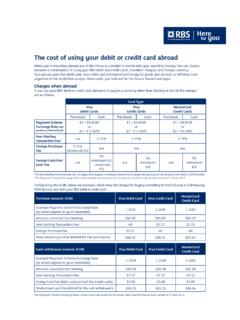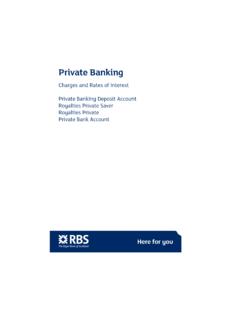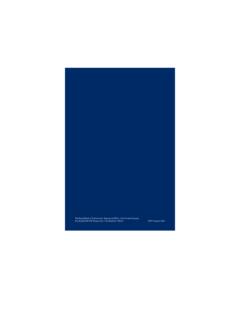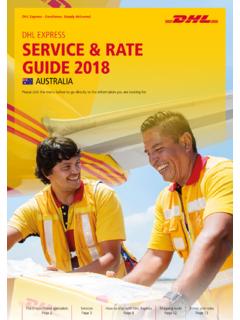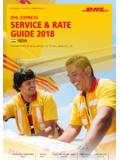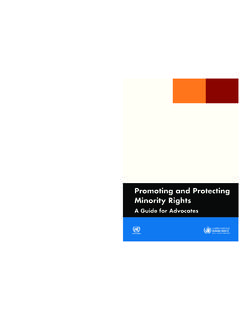Transcription of Guide to Trading Internationally Checking …
1 S in this section?The aims of this section are to:nprovide a brief background and describe internationalcodes of practicengive details of the standard for examination of documentsnsummarise the procedure for Checking documents undercreditsnsummarise common discrepancies in documents presentedunder creditsBackground and international codes of practiceThe almost universally accepted practices are outlined in thefollowing documents, both of which have been issued by theInternational Chamber of Commerce in Paris, and these UniformCustoms and Practice for DocumentaryCredits, ICC Publication no. 500, published in May 1993;ii. International Standard Banking Practice (ISBP) for theexamination of Documents under documentary credits, ICCpublication no. 645, published in January 600 is the currently applicable version of UCP,which was first published in 1933 and subsequently revised in1951,1962,1974,1983 and 2007,and is the code ofpracticefor the issue of documentary credits and the presentation ofdocuments drawn under for examination of documentsArticle 13 of UCP 600 requires that banks examine documentswith.
2 Reasonable care to ascertain whether or not theyappear, on their face, to be in compliance with the terms ofand conditions of the Credit .. The article also says that such compliance shall bedetermined by International Standard Banking Practice asreflected in UCP definition of International Standard Banking Practice iscontained not only in the articles of UCP 600 but also inInternational Standard Banking Practice (ISBP) publication these publications cannot cover every possible eventuality, itis also a functional standard ofdocument verification whichembodies honest,predictable practices, which are in contrastto sharp, dishonest and negligent practice .Documents can be, and are, rejected for genuine reasons and there are valid discrepancies upon which theymay be , there are also a variety of reasons whydocuments drawn under a credit are not honoured in othercircumstances and among them the most common causes ofdishonour are that:1.
3 The market price of the goods received under the credit bythe buyer has fallen to the extent that a loss would beincurred upon sale and therefore the documents arerejected for spurious reasons; in other words, thedocuments are examined with a fine-tooth comb to find anyperceived error to justify The goods have been received too late for their seasonalsale and so every minor error is picked on to justifyrejection of is regrettable that sometimes even international banks arenot averse to the rejection of documents on the grounds ofspurious errors and it is for this reason that documentcheckers must be especially vigilant when examining documents drawn under credits is not a science butan art, based on common sense and experience; sadly thereis often a tendency within staff and management to hidebehind a written text such as UCP rather than to use commonsense and good judgement based on experience in the for Checking documents under creditsWhat is outlined below is only a brief summary of questionswhich document checkers must ask and answer themselves;the summary is not meant to be an outline of the fullprocedures relating to Checking documents under credits butsimply an aide-memoire to keep the document checker alertduring the Checking letter/schedule enclosing the documents:Are theyfrom a recognised bank?
4 Are they from a presenter whohas no relationship with the bank? Are there slips of paperattached with nothing else? Care must be exercised to seethat the presenter is a genuine bank or presenting party.(Care possibility of fraud.)nIs the credit genuine? Have the signatures of paper creditsbeen verified or,in the case ofelectronically received credits,has the authentication been verified? (Care possible fraud.)nIs the credit available? Has it expired? Is the amountavailable sufficient? Are all previous drawings correctlyrecorded? Are all amendments on file?nHas the presenter noted any discrepancies? Ignore anyassertion that such discrepancies are/have been agreedwith the to Trading InternationallyChecking documents presented under creditsnIs the credit workable? That is to say, can the beneficiary fulfilall conditions regarding documentation or is there adocument to be presented by the applicant, a copy telexof approval of samples from the applicant of the credit?
5 NHave alllisted documentsbeen received and has timeanddate of receipt been noted on the bill Checking record?nHow is payment to be made,where to, to whom and who isbearing what charges?nWhat is your role as the bankerwho has received thedocuments? Are you the Issuing Bank, Advising Bank,Confirming Bank or Nominated Bank?nWhat is thetype of credit: at sight, usance, confirmed,transferable, back to back, red clause, revolving/stand by?Are there special departmental instructions about anyparticular types; how they should be dealt with and whoshould deal with them?nAre there any marketingopportunities for the Bank? Has themarketing manager been advised?nLatest date ofshipment: is the transport document datedafter the latest date of shipment evidenced in the credit?nDescription ofgoods:check the wording of the goods onthe invoice to see that it correspondsto the wording on thecredit; any shipment terms stipulated in the description ofthe goods on the credit must be shown on the Documents: on board notation to include vesseland port of loading where appropriate; port of loading andport of discharge to be as shown on the credit; are thereany qualifications about defective packing or defectivegoods?
6 Shipping marks: are they as shown on the credit, oron the invoice or any contract? Transhipment: is this shownon the transport document and is this allowed? Is it acharter party document or a sailing vessel document? Is thegoods description on the transport document inconsistentwith that shown on the invoice and the credit?nInsurance documenttendered must be as required by thecredit and it must not be a cover note unless specificallyallowed in the insurance document must be as called for in the credit a policy document called for in the credit must be a policydocument that is presented duly endorsed. The date of covermust be effective from at least the date of shipment not documentscalled for in the credit must be examinedin terms of what the credit for presentationof documents must be as requiredby the credit; regard must be had for article 43 of UCP : read this carefully and ensure that theconfirmation covers all existing above are some of the things that a document checkermust think about in Checking documents under credits; thecredit must be carefully read and examined from the top left-hand corner of page one to the bottom right-hand cornerand every page of the credit must be so examined, includingall the bank-to-bank instructions.
7 Every document presentedmust be checked to the stipulations in the credit, whereversuch stipulations are to be found in the credit and in thisrespect additional conditions must be looked all, the document checker must use common sense andgut feeling based on experience and this should only be overruledby a senior operational manager with hands on discrepancies in documents presented under creditsWhat is outlined below is a bullet-point summary of what iscommonly seen and is an aide-memoire only:nCredit expired: documents presented after expiry of the shipment: the date on the transport document is afterthe last date for shipment on the presentation: documents presented after the period forpresentation as specified in the credit or in terms of article43 of UCP not signed by beneficiary; drafts not endorsed;amount in excess of the credit; words and figures do notagree; tenor of draft shown : not issued by beneficiary; description of goodsnot consistent with the credit; unit price not as stipulated incredit; marks and numbers not consistent with those ontransport of origin: origin indicated is not as required bycredit; not issued by the party as required by the credit; dataon certificate of origin inconsistent with other Documents: date of shipment on transportdocument after the date stipulated in credit; the port ofloading not as required by credit; port of discharge not asrequired by credit; description of goods not consistent withthe invoice; does not show an onboard notation on bill oflading; incorrect vessel shown; bill of lading not issued bycarrier.
8 Bill of lading shows an intended vessel and anintended port of loading but the onboard notation does notadditionally evidence actual port of loading and actualvessel (see UCP 600 article 23 a ii para 4); onboardnotation on bill of lading not dated (UCP 600 article 23 a iipara 3; received for shipment bill of lading presented withno onboard notation;goods shipped on deck,but creditdoes not specifically allow deck shipment (UCP 600 article31 para i);claused bill oflading presented showingdefective condition of goods and packaging (UCP 600article 32); transport document does not identify lists: indicates packing not as required by credit;contains data inconsistent with other licence: not issued by authority named in the credit;goods shown on the licence not consistent with thecredit/invoice or other the publishers have taken great care in the preparation of this information they cannot, in any circumstances, accept responsibility for any loss, injury or damage (consequential orotherwise) resulting from any action taken in reliance on any information contained (or omitted from) these information and any opinions contained in these publications are not intended to be a comprehensive study of the topics covered nor to provide specific advice.)
9 The aim of these guides is toprovide some basic, general information only. Specific advice should be sought concerning individual contents of this information may not be copied in whole or in part without the express prior permission of The Royal Bank of Scotland Royal Bank of Scotland plcRegistered in Scotland No. 90312 Registered Office: 36 St Andrew Square, Edinburgh EH2 2YB.

